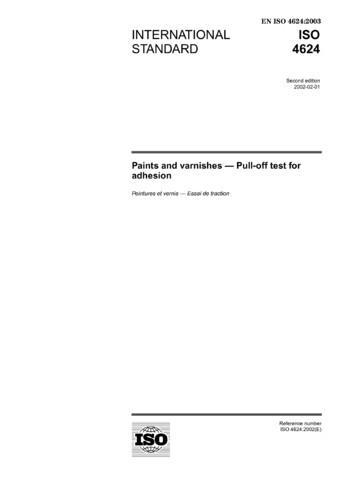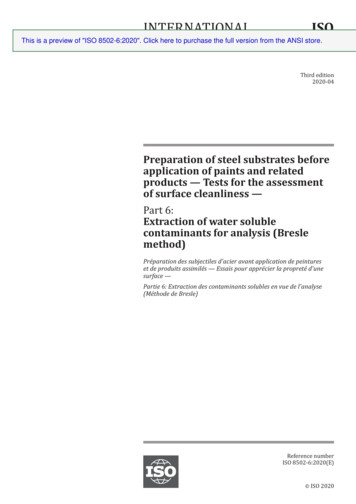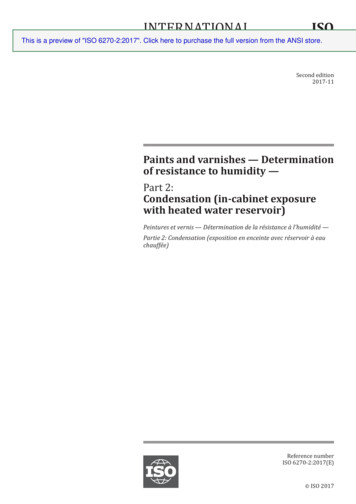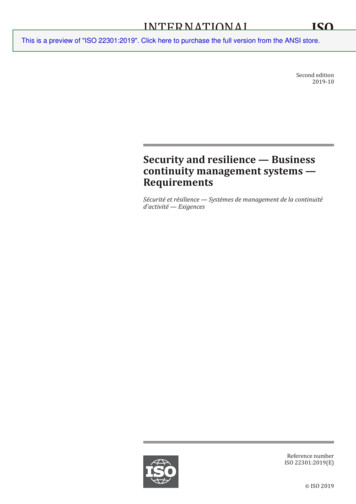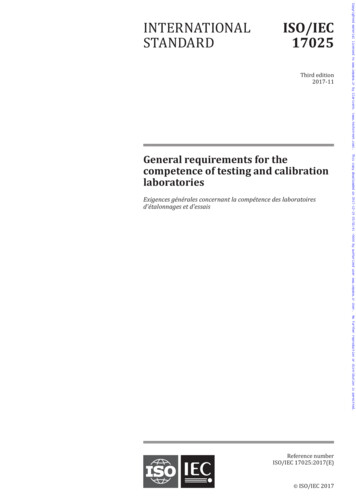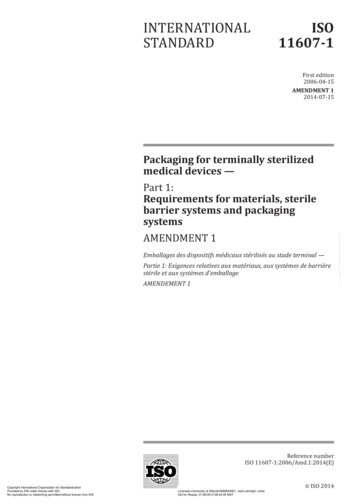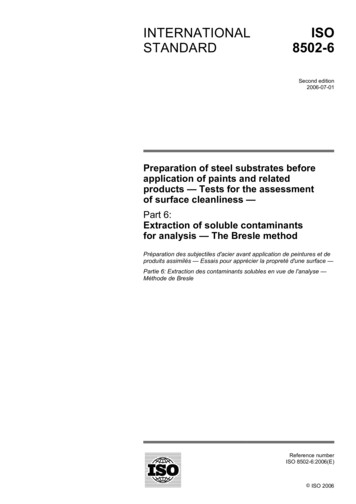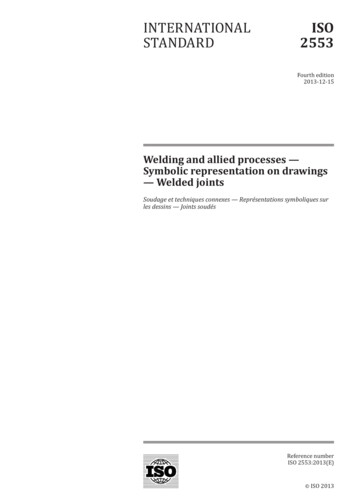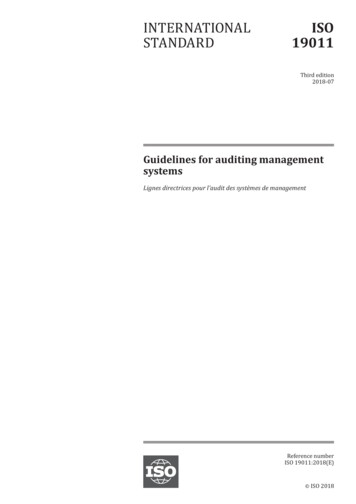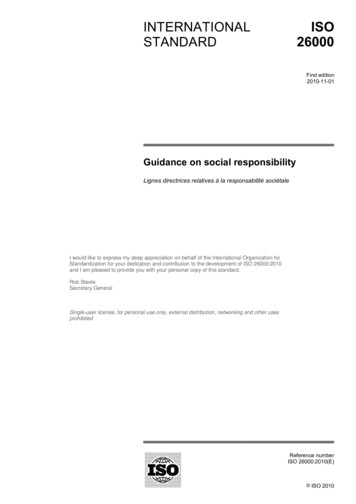
Transcription
ISO26000INTERNATIONALSTANDARDFirst edition2010-11-01Guidance on social responsibilityLignes directrices relatives à la responsabilité sociétaleI would like to express my deep appreciation on behalf of the International Organization forStandardization for your dedication and contribution to the development of ISO 26000:2010and I am pleased to provide you with your personal copy of this standard.Rob SteeleSecretary GeneralSingle-user license, for personal use only, external distribution, networking and other usesprohibitedReference numberISO 26000:2010(E) ISO 2010
ISO 26000:2010(E)PDF disclaimerThis PDF file may contain embedded typefaces. In accordance with Adobe's licensing policy, this file may be printed or viewed butshall not be edited unless the typefaces which are embedded are licensed to and installed on the computer performing the editing. Indownloading this file, parties accept therein the responsibility of not infringing Adobe's licensing policy. The ISO Central Secretariataccepts no liability in this area.Adobe is a trademark of Adobe Systems Incorporated.Details of the software products used to create this PDF file can be found in the General Info relative to the file; the PDF-creationparameters were optimized for printing. Every care has been taken to ensure that the file is suitable for use by ISO member bodies. Inthe unlikely event that a problem relating to it is found, please inform the Central Secretariat at the address given below.COPYRIGHT PROTECTED DOCUMENT ISO 2010All rights reserved. Unless otherwise specified, no part of this publication may be reproduced or utilized in any form or by any means,electronic or mechanical, including photocopying and microfilm, without permission in writing from either ISO at the address below orISO's member body in the country of the requester.ISO copyright officeCase postale 56 CH-1211 Geneva 20Tel. 41 22 749 01 11Fax 41 22 749 09 47E-mail copyright@iso.orgWeb www.iso.orgPublished in SwitzerlandiiSingle-user license, for personal use only, externaldistribution, networking and other uses prohibited ISO 2010 – All rights reserved
ISO 26000:2010(E)ContentsPageForeword .vIntroduction.vi1Scope .12Terms and definitions .233.13.23.33.4Understanding social responsibility .5The social responsibility of organizations: Historical background .5Recent trends in social responsibility.5Characteristics of social responsibility .6The state and social s of social responsibility .10General .10Accountability.10Transparency .10Ethical behaviour.11Respect for stakeholder interests .12Respect for the rule of law .12Respect for international norms of behaviour .13Respect for human rights .1355.15.25.3Recognizing social responsibility and engaging stakeholders .14General .14Recognizing social responsibility .14Stakeholder identification and engagement.1666.16.26.36.46.56.66.76.8Guidance on social responsibility core subjects.19General .19Organizational governance .21Human rights .23Labour practices.33The environment.40Fair operating practices.48Consumer issues.51Community involvement and development .6077.17.27.37.47.57.67.7Guidance on integrating social responsibility throughout an organization .69General .69The relationship of an organization's characteristics to social responsibility.69Understanding the social responsibility of an organization.70Practices for integrating social responsibility throughout an organization .74Communication on social responsibility .76Enhancing credibility regarding social responsibility.78Reviewing and improving an organization's actions and practices related to socialresponsibility .80Voluntary initiatives for social responsibility.827.8Annex A (informative) Examples of voluntary initiatives and tools for social responsibility.85Annex B (informative) Abbreviated terms .98Bibliography.99 ISO 2010 – All rights reservedSingle-user license, for personal use only, externaldistribution, networking and other uses prohibitediii
ISO 26000:2010(E)FiguresFigure 1 — Schematic overview of ISO 26000.ixFigure 2 — Relationship between an organization, its stakeholders and society . 15Figure 3 — The seven core subjects . 20Figure 4 — Integrating social responsibility throughout the organization. 69BoxesBox 1 — Summary information to assist users of this International Standard .xBox 2 — Gender equality and social responsibility . 7Box 3 — ISO 26000 and small and medium-sized organizations (SMOs). 8Box 4 — Understanding complicity. 13Box 5 — Benefits of social responsibility for an organization . 20Box 6 — The International Bill of Human Rights and the core human rights instruments . 23Box 7 — Child labour . 32Box 8 — The International Labour Organization . 33Box 9 — Joint labour-management health and safety committees . 40Box 10 — Examples of climate change adaptation actions. 46Box 11 — UN Guidelines for Consumer Protection. 52Box 12 — Consumer dispute resolution . 58Box 13 — Millennium Development Goals . 62Box 14 — Contributing to community development through an organization's core activities . 63Box 15 — Reporting on social responsibility . 77Box 16 — Certifiable initiatives and initiatives connected to commercial or economic interests . 84Box 17 — Non-endorsement of initiatives by ISO . 86ivSingle-user license, for personal use only, externaldistribution, networking and other uses prohibited ISO 2010 – All rights reserved
ISO 26000:2010(E)ForewordISO (the International Organization for Standardization) is a worldwide federation of national standards bodies(ISO member bodies). The work of preparing International Standards is normally carried out through ISOtechnical committees. Each member body interested in a subject for which a technical committee has beenestablished has the right to be represented on that committee. International organizations, governmental andnon-governmental, in liaison with ISO, also take part in the work. ISO collaborates closely with theInternational Electrotechnical Commission (IEC) on all matters of electrotechnical standardization.International Standards are drafted in accordance with the rules given in the ISO/IEC Directives, Part 2.The main task of technical committees is to prepare International Standards. Draft International Standardsadopted by the technical committees are circulated to the member bodies for voting. Publication as anInternational Standard requires approval by at least 75 % of the member bodies casting a vote.Attention is drawn to the possibility that some of the elements of this document may be the subject of patentrights. ISO shall not be held responsible for identifying any or all such patent rights.ISO 26000 was prepared by ISO/TMB Working Group on Social Responsibility.This International Standard was developed using a multi-stakeholder approach involving experts from morethan 90 countries and 40 international or broadly-based regional organizations involved in different aspects ofsocial responsibility. These experts were from six different stakeholder groups: consumers; government;industry; labour; non-governmental organizations (NGOs); and service, support, research, academics andothers. In addition, specific provision was made to achieve a balance between developing and developedcountries as well as a gender balance in drafting groups. Although efforts were made to ensure balancedparticipation of all the stakeholder groups, a full and equitable balance of stakeholders was constrained byvarious factors, including the availability of resources and the need for English language skills. ISO 2010 – All rights reservedSingle-user license, for personal use only, externaldistribution, networking and other uses prohibitedv
ISO 26000:2010(E)IntroductionOrganizations around the world, and their stakeholders, are becoming increasingly aware of the need for andbenefits of socially responsible behavio
ISO 26000: First edition 2010-11-01 Guidance on social responsibility Lignes directrices relatives à la responsabilité sociétale : I would like to express my deep appreciation on behalf of

